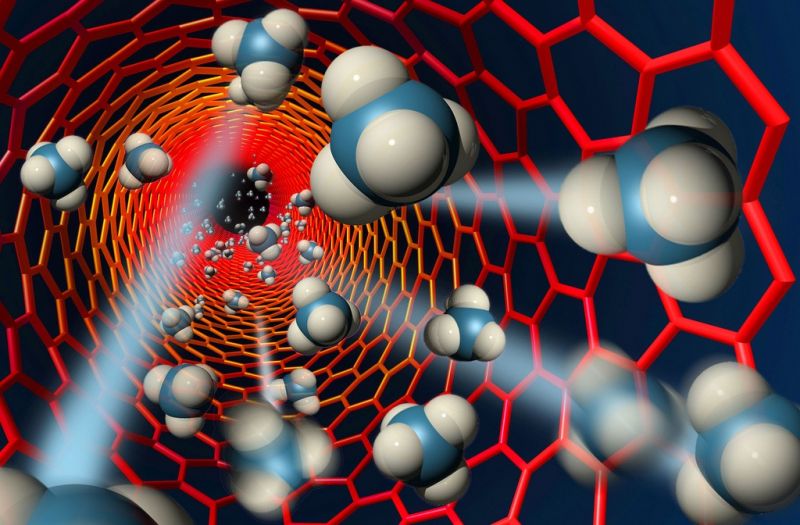From Seawater to Drinking Water? Nanotubes Upgrade Desalination Efforts
Published on by Engr.Chinenye Justin Nwaogwugwu., MANAGING DIRECTOR/FOUNDER: Macjames Global Resources Ltd and Macjames Ikiomoye Technologies Ltd in Technology
Looking to nature for inspiration, scientists from Lawrence Livermore National Laboratory (LLNL) and Northeastern University have used carbon nanotubes to mimic the water-filtering proteins of the body.
The super-thin graphene cylinders improve water desalination efforts and support a new generation of high-flux membranes.
Going for the Gold Standard
 To enable water to flow more rapidly into and out of our cells, the human body features membrane channels known as aquaporin proteins. Aquaporins also include a filter of clustered amino acids to block the passage of ions and specific molecules.
To enable water to flow more rapidly into and out of our cells, the human body features membrane channels known as aquaporin proteins. Aquaporins also include a filter of clustered amino acids to block the passage of ions and specific molecules.
For researchers like LLNL principal investigator Alex Noy, the efficiency of the protein's water transport is a "gold standard" to be reached — and surpassed. Using nanotubes, the scientists copied the structure of the biological membranes, creating pores that provide the same function.
The hollow, super-narrow tubes of graphene, 0.8 nm in diameter, support a high flux of water and enhanced transport.
“A lot of the transfer speed comes from the fact that the channel is so small that it squeezes water into a single line of molecules,” said Noy, who spoke with Tech Briefs . Noy co-authored a study on the nanotube development, appearing in the Aug. 24 edition of Science.
Compared to the slightly rougher amino-acid walls of the body’s aquaporin proteins, the synthetic water channel is slick, made from the carbon nanotube’s atomically smooth surface.
“Because it's a straw, that's pretty ideal. It has walls that are very straight and very slippery, and things tend to go through it very, very fast,” said Noy. “The transfer is so fast that we can beat this biological standard."
Testing the Waters
Additional scientists developing the carbon-nanotube channel included Ramya Tunuguntla, an LLNL postdoctoral researcher, and Meni Wanunu, a physics professor at Northeastern University.
To study the transport properties, the team placed nanotube pores in the walls of tiny membrane vesicles. By dropping the vesicles in an ionic solution, osmotic pressure squeezed water from the sacs, leaving behind the bigger particles like the salt.
The nanotube uses a similar water-filtering mechanism to the biological protein. Just as in the protein, the nanotube channel diameter is very small, allowing water to flow through very easily. Bigger salt ions, coated with a shell of tightly bound water molecules, tend to be blocked by the nanotube pore, said Noy.
Using computer simulations and experimental studies, the researchers tested water transport through carbon nanotubes featuring diameters larger than 1 nm. The results demonstrated enhanced water flow, but did not match the transport efficiency of biological proteins and did not separate salt efficiently, especially at higher salinities. The LLNL team discovered that the smaller-diameter —0.8 nm — nanotubes boosted performance.
What's Next
Although Noy and his colleagues proved the physics and water-filtering capabilities of carbon nanotubes, the membrane requires a more robust structure, to handle the high pressure needed for desalination.
“Right now, the membranes that we use are lipid membranes, which are extremely thin and fragile, and in no way, shape, or form can support that pressure,” said Noy. “So there needs to be a lot of engineering and development to actually convert those transport properties into something that can be used commercially.”
Given the global need for fresh water, a filter that could turn the ocean’s vast supply into drinking water is an enticing idea. The team hopes to create a higher-strength membrane made from the carbon nanotube pores — a technology that would continue to rival even nature’s best efforts.
“We were actually able to create a synthetic membrane channel that works better than a protein,” said Noy. “Anytime you can beat nature at its own game, it’s exciting.”
Attached link
http://www.techbriefs.com/component/content/article/1198-tb/news/news/27442?utm_source=TBnewsletter&utm_medium=email&utm_campaign=20170905_Main_INSIDER&eid=376628296&bid=1855980Media
Taxonomy
- Desalination
- Sea Water Desalinisation
- Sustainable Desalination
- Desalination
- Graphene